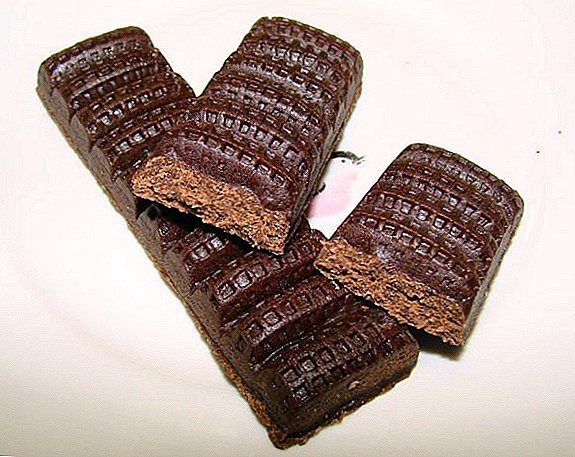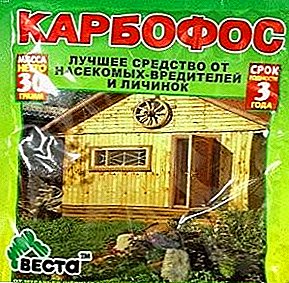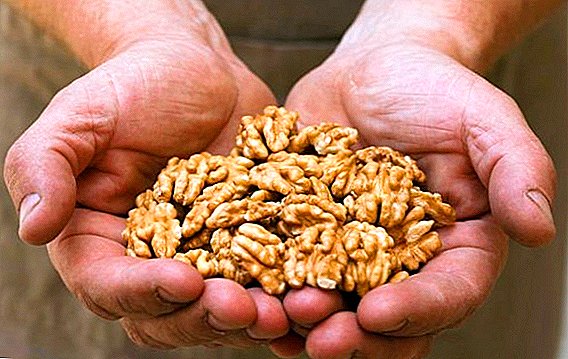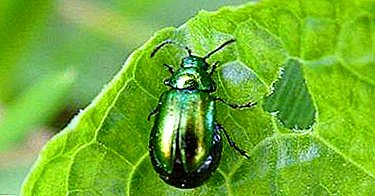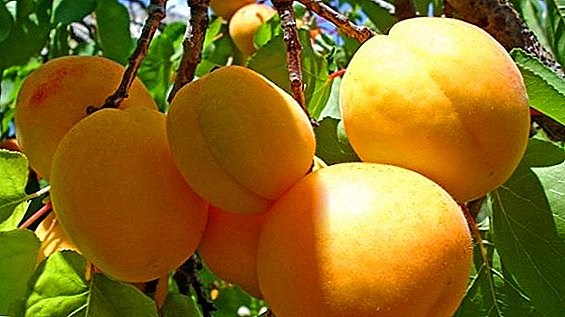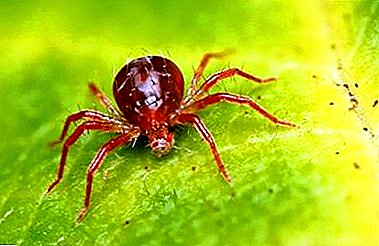
A spider mite is a small pest that often settles in a garden, a vegetable garden or on home flowers. Appearing on a single plant, the parasite infects its neighbors very quickly. Tick control is laborious, as it requires at least 2-3 treatments of the plant.
The article will tell you how to deal with a pest at home or a greenhouse.
What you need to know about the pest?
The parasite feeds on plant sap. Most often settles on the underside of the leaves, wrapping the leaf plate with a thin and almost invisible cobweb.
Color pest varies from light green to brown. There are spider mites in all points of the globe, except Antarctica. Scientists distinguish more than 1000 species.
Spider mites are not insects. In insects there are 3 pairs of limbs, and in ticks - 4. These parasites belong to the class of Arachnids.
Causes of appearance on indoor and garden plants
 Favorable conditions for life and reproduction - dry and warm air, temperature from +30 degrees and humidity of 35-45%. In apartments, ticks often appear in the winter when they turn on the heating.
Favorable conditions for life and reproduction - dry and warm air, temperature from +30 degrees and humidity of 35-45%. In apartments, ticks often appear in the winter when they turn on the heating.
The pest can get into the room through the window openings, it can be brought with a new plant or with a new primer for transplanting.
On beds the parasite lives in the old fallen down foliage, and then - creeps on a plant.
First steps when detected on flowers
To detect the presence of a pest can be on a number of characteristics. These include:
- appearance of small discolored dots on the sheet plate;
- growth points to the size of the spots;
- the presence of cobwebs on the back of the sheet;
- leaf rolls up and fades.
With a strong defeat leaves fall off massively. As a result, the plant weakens, languishes and in the absence of timely assistance, dies.
Right away After detecting signs of infection, a number of immediate actions should be taken.. The first and obligatory stage is washing all parts of the infected plant with a concentrated solution of laundry soap. This will reduce the number of parasite populations. Next you need to wash and sanitize all the pots and saucers (put in boiling water), window sill, glass, frame and even curtains.
How to fight: detailed instructions
The general algorithm for eliminating the parasite includes the following actions:
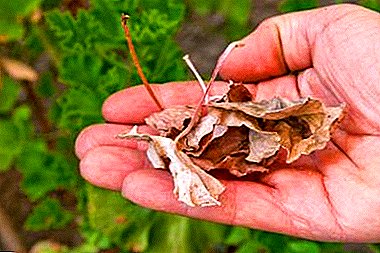 Rip off all wilted and yellowed leaves (by removing them, you can immediately get rid of 25% of parasites).
Rip off all wilted and yellowed leaves (by removing them, you can immediately get rid of 25% of parasites).- Isolate adjacent plants.
- Wash the plants (infected and nearby) with water with soap. Alternative - dishwashing detergent.
- Water the plant with plenty of water (this will wash off the remnants of soap), you also need to shed the soil.
- Put a plastic bag on the pot with the infected plant, put it in a dark place for a few days.
These actions will need to be repeated 2 more times at weekly intervals.
Chemical destruction
Chemicals can get rid of ticks much faster.. It is necessary to carry out the treatment several times with an interval of 5-10 days. For the destruction of spider mites are suitable insectoacaricides (Fitoverm, Vertimek, Kleschevit) and acaricides (Apollo, Sunmite, Flumayt). See the dosage in the instructions, as the proportions for home and garden plants will be different.
ATTENTION! Chemical preparations are used only in accordance with the instructions, since their high concentration can destroy the plant.
Differences and specifics:
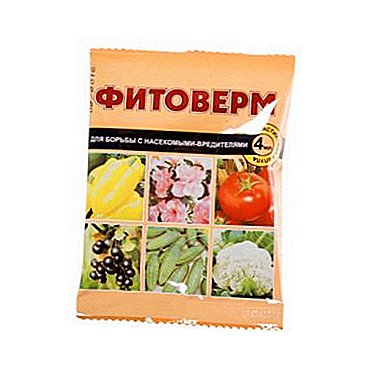 Insectoacaricides kill all insects. These are drugs designed to fight simultaneously with harmful insects and mites.
Insectoacaricides kill all insects. These are drugs designed to fight simultaneously with harmful insects and mites.Basically, these drugs are toxic, apply them better on the street or in rooms with good ventilation. The most effective is Actellic and Fitoverm.
 Acaricides - Chemicals that are used only to combat ticks.
Acaricides - Chemicals that are used only to combat ticks.Used to protect cultivated and indoor plants, as well as for the treatment of premises. On some packages there is an inscription "with an ovicidal action" - this means that they will destroy not only adult individuals, but also their larvae.
Folk methods of struggle
If the plant is not in a state of neglect, then folk methods will be safer and more benign.
| Means | Preparation and use |
| Soap solution. |
|
| Medical alcohol (96%). | Moisten a tampon or cotton wool, wipe the leaves. Mature ticks will be destroyed, but the larvae will remain. Alcohol has the ability to quickly evaporate and the leaves should not be damaged. But still it is better not to carry out this procedure with plants that have thin leaves. |
| Garlic infusion |
|
| Infusion of onion peel |
|
| Black henbane infusion |
Spray the plant 2 times a day for 3-4 days with any obtained product. |
| Broth from tops of potatoes |
Use for regular spraying. |
Processing plants tinctures and decoctions should be carried out in the evening.
If the effect is not observed, it is better not to delay and use chemicals.
More information about the fight against spider mites with the help of store products and folk remedies, read here.
Preventive measures
 The main factor for the appearance of spider mites is dry air, therefore the best warning is spraying water on plants during dry weather. At the same time it is necessary to ensure that water does not accumulate in the core of the stem.
The main factor for the appearance of spider mites is dry air, therefore the best warning is spraying water on plants during dry weather. At the same time it is necessary to ensure that water does not accumulate in the core of the stem.
Pay special attention to plants in the winter season, as due to the decrease in the length of the day and low temperatures, water evaporates slowly.
To get rid of the parasite, the plant should not be immersed in water, because when in contact with water, ticks appear armor in the form of air bubbles.
Homemade solution will help prevent infection.
- To make it you need to mix 20 g of cinnamon, 40 g of Italian herbs, pour 1 l of water.
- Boil, cool and add 40 g of chopped garlic.
- You can also add 2-3 drops of soap.
In order to prevent the leaves to handle every 2 days for 2 weeks.
Nuances of prevention at the site:
- Regular processing of garden tools with disinfectants.
- Digging the soil in the fall.
- During the period of fruiting - regular weeding and subsequent loosening.
- Compliance with crop rotation tips.
- Watering regular (as the earth crust dries), soil mulching.
- Daily inspection of leaves for infection. When detecting traces of the parasite - cut off the infected leaf and burn.
Getting rid of spider mites can be a long and painful task. Try not to create conditions that beneficially affect the reproduction of the parasite. (heat, moisture, dryness).
At home, do a wet cleaning, observe sanitary standards, wipe the dust not only on the cabinets, but also on the leaves. At the site regularly air the greenhouse, time to get rid of weeds.


 Rip off all wilted and yellowed leaves (by removing them, you can immediately get rid of 25% of parasites).
Rip off all wilted and yellowed leaves (by removing them, you can immediately get rid of 25% of parasites). Insectoacaricides kill all insects. These are drugs designed to fight simultaneously with harmful insects and mites.
Insectoacaricides kill all insects. These are drugs designed to fight simultaneously with harmful insects and mites. Acaricides - Chemicals that are used only to combat ticks.
Acaricides - Chemicals that are used only to combat ticks.